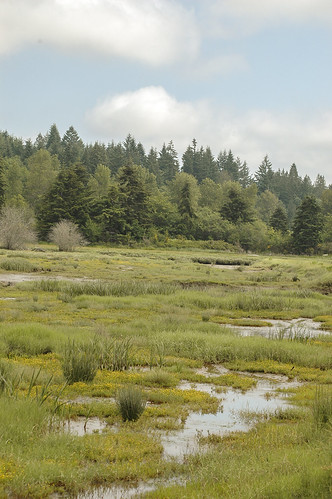
When many people think of Washington State, they imagine rain, coffee and apples. My view is much more complex and nuanced, thanks to our team at NRCS who showed me diverse agricultural landscapes, including the state’s major estuary - Puget Sound.
During my visit, I was greeted by an idyllic landscape steeped in history. Early settlers to the Puget Sound area converted marshlands into pastures and hayfields. We visited one such area now known as Klingel Wetlands, where levee systems were installed in the 1890s and 1950s to prevent flooding.
These man-made structures converted the wetlands to an area that could be farmed marginally, but damaged the shoreline habitat and upset the delicate biological and chemical processes unique to the salt marsh estuary of Puget Sound on which many fish and wildlife depend.
The vibrancy and complexity of the Puget Sound makes it especially fragile. Protecting the Sound not only protects wildlife habitat, but also a $20 billion annual economy and hundreds of thousands of jobs.
Estuaries, like Puget Sound, are where freshwater and saltwater meet. Plants, fish, and animals adapt to this unique environment that includes saltwater, nutrients carried on tides from the ocean, and sediment and nutrients from freshwater streams.
This week, NRCS and partners are celebrating National Estuaries Week by highlighting some of the efforts to improve health of estuaries, including the work of landowners, organizations and communities in the Puget Sound area.
One of these impressive efforts is by the Great Peninsula Conservancy, which worked with NRCS to set up a permanent easement through the former Wetlands Reserve Program for this area in 2003.
Once the easement was secured, NRCS staff led by Rachel Maggi, Area Biologist in the Brush Prairie office, Molly Dawson, Area Engineer in the Olympia office, and Dan Larsen, Planner in the Port Orchard office, worked with Great Peninsula Conservancy and the Hood Canal Salmon Enhancement Group to restore these former wetlands to their previous glory.
The first problem: the levees installed by the early settlers to keep saltwater at bay allowed freshwater plants to flourish, overtaking the area. Once the levee was removed, saltwater from Puget Sound was able to flow freely into the wetlands for the first time in 100 years, restoring the historical balance of fresh and saltwater to the area resulting in a magnificent estuary that is now teeming with life.
Another great example of restoration work can be found not far from the Klingel Wetlands at the Farm at Water’s Edge, where work is underway to replace culverts that blocked fish from swimming upstream with ones that allow for easy passage, with the additional benefit of returning Mindy Creek to its original meandering nature.
Mindy Creek had been straightened to allow for easy plowing of fields near its edge but this resulted in the Creek being little more than a drainage ditch. The restoration provides different depths and curves that allow fish to easily navigate, rest, hide and spawn.
It’s great to see how landowners and groups can take advantage of conservation programs available through NRCS and how our dedicated staff works every day to truly make a difference on the landscape.
My experience in Washington was wonderful. It was inspiring to see how so many landowners and conservation partners voluntarily work to make positive difference in restoring this estuary. I’ve learned firsthand – Washington is more than rain, coffee and apples. Washington is about people doing what’s right and taking care of their natural treasures like Puget Sound.



